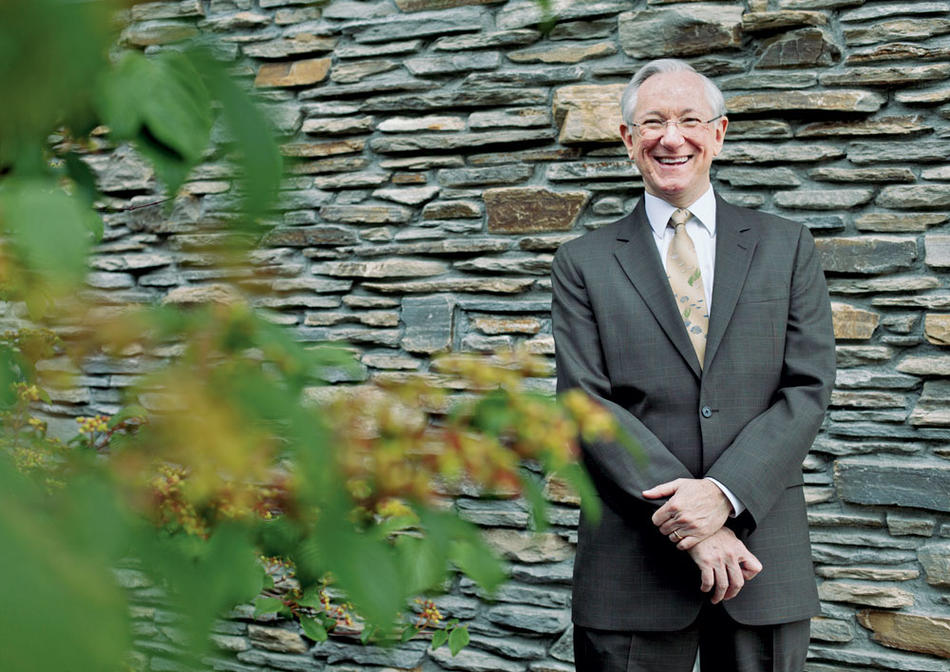Sean C. Solomon can tell you a lot about a planet by looking at its surface. Smooth plains? The sign of lava flow, and thus a fiery interior. Long vertical cracks? A side effect of heat expansion. Mountainous ridges? Left behind a few billion years ago after the planet cooled and deflated.
“In my field, you learn to make good use of all of the evidence you have,” says Solomon, “because it certainly isn’t easy to get.”
Solomon, a geophysicist who is internationally renowned for his studies of Mercury, Venus, and Mars, was recently named director of Columbia’s Lamont-Doherty Earth Observatory (LDEO). Located on a 157-acre campus in Palisades, New York, LDEO is home to two hundred geologists, seismologists, oceanographers, and climatologists.
“I’ve admired Lamont my whole career,” says Solomon. “It is a pillar of earth science and a very special place. The scientists here are true explorers — fiercely independent and creative.”
If it seems odd that a space researcher would be picked to lead a group of earth and environmental scientists, Solomon can explain: the study of Earth and the study of other planets are closely related, and have always informed each other. LDEO seismologists, he points out, were the first to measure seismic signals on a celestial body other than Earth, when Neil Armstrong and his Apollo 11 crew delivered their instruments to the moon in 1969.
“Back then, Lamont studies on Earth’s plate tectonics and the moon were revolutionizing our understanding of how all planets evolve,” he says. “A lot of the seismology work done at Columbia in the 1960s actually inspired me to go into geophysics.”
Great shakes
Early in his career, Solomon conducted research on Earth’s plate tectonics, earning his PhD in geophysics from the Massachusetts Institute of Technology in 1971. He stayed on there for another two decades to teach and oversee one of the earliest ocean-bottom seismology labs. Solomon and his graduate students, by placing instruments on the bottom of the Atlantic, Pacific, and Indian Oceans, gained insights into how the shifting and grinding of tectonic plates create new crust.
Solomon then used his knowledge of Earth’s plate tectonics to explain the development of other celestial bodies. In 1978, he published a paper in the journal Geophysical Research Letters theorizing that billions of years ago, the moon, Mercury, and Mars — relatively small bodies that do not appear to have multiple tectonic plates — each began cooling and contracting at a pace roughly associated with its size and internal temperature. Over the years, additional research on the moon, Mercury, and Mars has supported Solomon’s argument.
“Sean’s model still represents the paradigm today, which is absolutely amazing,” says G. Michael Purdy, a geophysicist who was LDEO’s director from 2000 to 2011. “Most papers in our field are made irrelevant within five or ten years, because the field is young and our knowledge is rapidly improving.”
Solomon, 66, currently serves as principal investigator of NASA’s Messenger mission to Mercury and co-investigator of NASA’s Grail spacecraft mission to the moon.
The Messenger spacecraft, which entered orbit around Mercury last fall after a nearly seven-year journey to the innermost planet in our solar system, is now mapping the planet’s surface and taking spectrometer measurements to assess its chemical composition and that of its thin atmosphere.
“These observations will tell us more about the planet’s history and how it has been changing,” says Solomon. “And this, in turn, will tell us more about how all planets evolve — including our own.”
Our future planet
Solomon came to Columbia July 1, succeeding LDEO interim director Arthur Lerner-Lam, a seismologist who stepped into that position last year when Purdy was named the University’s executive vice president for research. Solomon was previously a research scientist and director emeritus at the Carnegie Institution in Washington, DC.
Solomon says he does not expect to make radical changes at LDEO: “I’m definitely not coming to Columbia with a particular agenda to strengthen planetary science. Might I like to see some new areas of research grow here? Sure. But those types of priorities will be developed in consultation with my new colleagues. My primary goal is to preserve Lamont’s existing strengths and nurture them.”
One of the reasons he came to Columbia, Solomon says, is that he believes in the mission of its Earth Institute, a University-wide enterprise that brings together researchers whose work has the potential to improve environmental, social, and economic sustainability, especially in the world’s poorest countries. (Solomon served on the advisory board of the Earth Institute, which encompasses LDEO, from 2004 until last year.)
“I think it’s a wonderful model — to take our scientific knowledge and use it to address the future state of our planet, whether this pertains to resource management, public health, poverty amelioration, or climate-change mitigation,” says Solomon. “I believe this is the way scientists at an international university should be approaching their work.”



